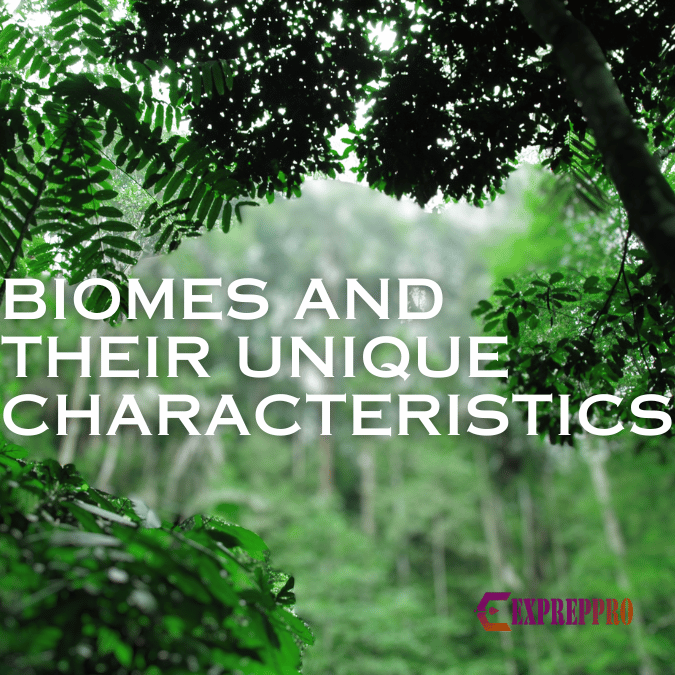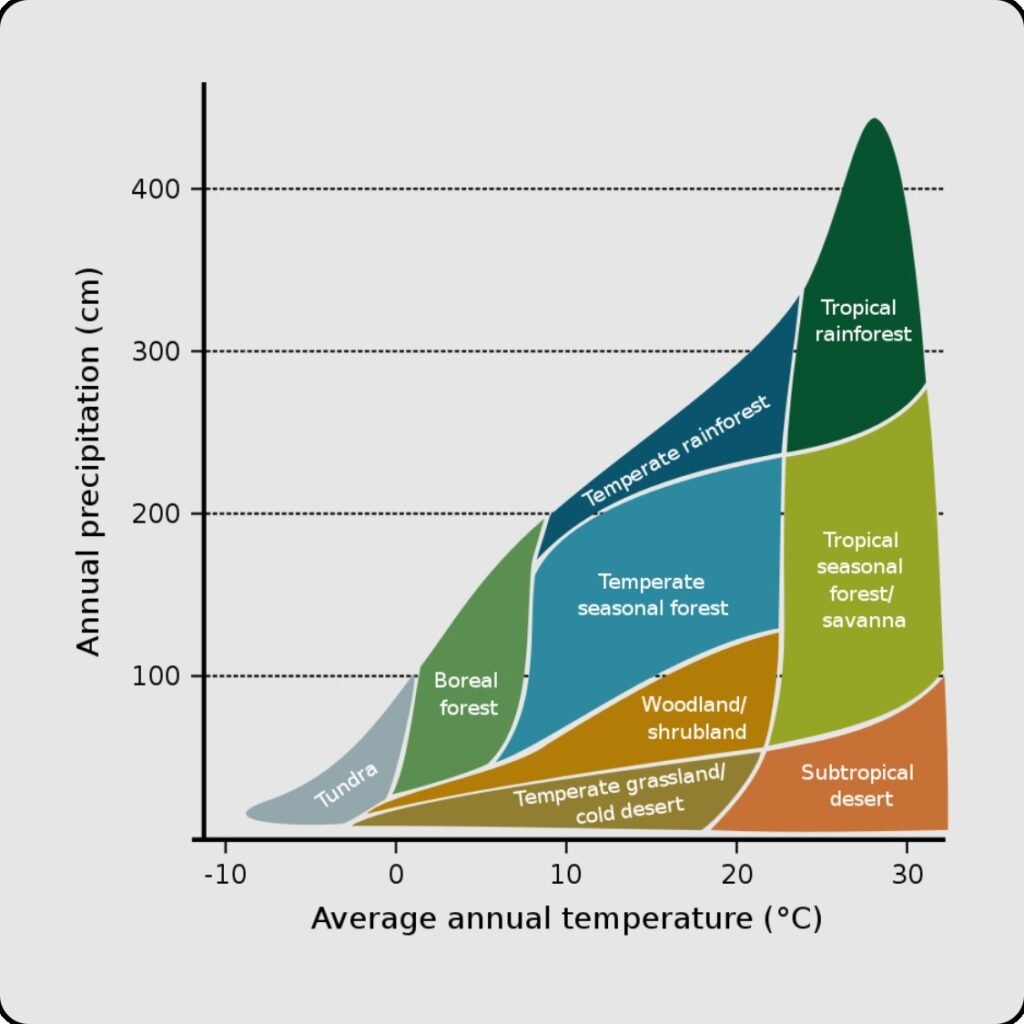
A biome is a large land area with a characteristic group of organisms adapted to its environment. In 1934, F.E. Clements and V.E. Shelford created a classification based on the broad-scale distribution of plants and associated animals. They named these biotic units Biomes. In his book “Communities and Ecosystems“, Robert Whittaker divided terrestrial ecosystems into 26 types. However, we will look into the characteristics of eight types of biomes.
FACTORS THAT INFLUENCE THE BIOMES –
Rainfall and temperature influence the development of terrestrial biomes in various ways.
- The availability of moisture decreases from the tropics to temperate regions.
- If we move from the equator to the poles, the mean annual temperature decreases, and seasonal variation of temperature increases [which means the day length increases].
- Increasing latitude decreases average annual precipitation. Since the temperature decreases with latitude, the amount of moisture in the air falls. This decrease in moisture is responsible for the reduction in rainfall.

TUNDRA BIOME –
It is the dominant biome encircling the top of the northern hemisphere or located on the northern edge of Asia, North America, and parts of Antarctica. The word ” Tundra ” derives from the Finnish word “Tunturi, ” meaning a treeless plain.
Artic tundra falls under two broad categories
- With 100% plant cover and wet to moist soil.
- Polar desert with less than 5% plant cover and dry soil.
The Tundra is quite flat, with a very dry and cool summer and freezing winter. Another striking feature is the presence of permafrost. It is a thin, nutrient-deficient upper soil that freezes each winter and thaws each summer. It reduces plant growth below and above ground and minimises the aeration and nutrient content of the soil. Permafrost is also responsible for limiting the activity of soil microorganisms.
Plant root systems are shallow[root-to-shoot ratio is 3:1 or 10:1]. Tundras have a short growing season. Another feature of Tundra is Solification terraces. The downward movement of super- saturated soil over the Permafrost creates Solification terraces, ultimately resulting in the moulding of landscapes called Cryoplanation.
Cotton Grass, Dwarf Willows, Briches, Alder, Lichens, Sphagnum, Frobs, Caribou, Musk Ox, Arctic fox, and Wolf are present in the Arctic tundra. Plants propagate almost entirely vegetatively, and most insects show Diapause( development and metabolic dormancy).
Before the end of the growing season, the plant withdraws nutrients from its leaves and transfers them to roots[sequestering ten times the amount stored by temperate grassland].
High mountains nurture the Alpine tundra [just above the treeline]. Alpine Tundra is also icy, with moisture levels varying from dry to wet. It generally lacks Permafrost or has little Permafrost.
Oil exploration in the tundra region is a severe threat to this biome.
TAIGA BIOME-
They were primarily seen in a broad circumpolar belt area across the Northern Hemisphere, throughout most of North America, Europe and Asia. Long, frigid winters and short, warm summers are characteristics of Taiga or Boreal forest. The soil is nutrient-poor due to low decomposition rates. Plant and animal diversity is very low, but animal diversity is more than the animal diversity seen in Tundra.
Soils are primarily spodosols characterised by a thick organic layer. The mineral soil beneath mature coniferous forests is infertile[ comparatively]. Fires are common in the taiga. The typical fauna include Lynx, Pine Martin, Siskns, Spruce Budworm, Red Squirrel, and Caribou. The flora comprises Subalpine Fir, Ponderosa Pine, Gaint Sequoia, and Norway Spruce.
Most of the trees are conifers.
TEMPERATE FORESTS BIOME –
Relatively moderate conditions, such as warm summers, cool winters, and good rainfall(600 to 2000 mm per year) in the humid mid-latitude regions, result in temperate forests dominated by broad-leaf deciduous trees. In the mild, moist southern hemisphere, temperate evergreen forests are predominant. In the south hemisphere, temperate deciduous forests are seen only in the drier parts of the Southern Andes mountains. In Chile, a frost-free temperate evergreen forest is seen due to an oceanic climate. New Zealand and Tasmania are the other regions with temperate evergreen forests but with predominantly conifers.
In deciduous forests of the temperate region, the end of the growing season is marked by Autumn colours of leaves. Deciduous forests usually show four vertical strata
1. Upper canopy
2. Lower tree canopy
3. Shrubs
4. Ferns and Mosses
Alfisols, Ultisols and Inceptisols are the soil types present.
Alfisols are moderately leached soils with high native fertility. They are associated with glacial materials( more in northern regions). Utisols are leached acidic forest soils with relatively poor fertility. Inceptisols are weakly developed soil with minimal horizon development.
TEMPERATE SHRUBLAND (MEDITERRANEAN BIOME) –
It is found on the southwest side of large landmasses at latitudes of 300 to 400, north and south. Temperate shrubland is dominated by evergreen shrubs and sclerophyllous trees [ scleros- hard, phyllo -leaf ]. The Mediterranean biome is known by many different names in different parts of the world. Chaparral, Maquis, Matorral, and Fynbos are the alternate names of this biome. It spans from arid to humid, depending on the place.
Hot, dry summers with small protracted drought and cool, moist winters(100 -120 c) with winter precipitation are important characteristics of the Mediterranean biome(65% of rainfall occurs during winter). Hot summers and wet winters are unique to the Mediterranean biome. In winter, weak subtropical high-pressure cells move toward the equator, resulting in moist air movement, creating rainfall.
The flow of dry air brings hot, dry weather during summer. Fire is frequent during these periods. Gray Kangaroos, Jackrabbits, Coyotes, and Deer are common species in this biome. The largest area of this biome is located in a discontinuous belt around the Mediterranean Sea. The Mediterranean biome in South Africa is limited to the mountain regions of the Cape Province and is known as Fynbos. In Australia, this biome is known as Malle. Here, the dominant tree is low-growing eucalyptus. Chaparral is the name for the Mediterranean biome in North America, and the dominant trees are scrub Oak and Chamise.
The soil present here is classified as Alfisols.
DESERTS BIOME-
Deserts are found near 300 latitudes north and south of the globe. Here, the moisture-deprived air mass creates the deserts. In extreme cases, deserts receive no rain ( Atacama desert). In the region near 300 (between 150 & 300) latitude, the moisture-less air is carried along the ITCZ side to form semi-permanent pressure cells ( also influence the desert’s formation). Thorny small-leaf succulents survive even though the vegetation is scanty. Three major types dominate this sparse vegetation
- Ephemal annual herbs that grow only when sufficient moisture is available.
- Non-succulent shrubs and trees whose deep tap roots may reach the water table and help to survive.
- Succulent xerophytes which store water in their tissues.
Temperate deserts usually lie in a rain-shade region or are located far inland. They are not always hot. Cold deserts like Gobbi and Turkestan desert are also there. Most desert soils are poorly developed Entisols and Aridisols.
TEMPERATE GRASSLAND –
Here, the rainfall is between 25 and 80 cm per year. This biome has chill winters and warm summers with moderate precipitation. Its deep, fertile soil makes it vulnerable to land clearing( for agriculture).
The dominant soil is Mollisol. Here, productivity is related to annual precipitation. In the Eurasian region, this biome is known as Steppes. It is known as Velds( in Orange Free State or Free State) in South Africa. In North America, this biome is known as the Prairies. In New Zealand and Australia, this biome is known as Tussocks. Pampas is the name for this biome in South America.
TOPICAL SAVANNA –
Originally used to describe the treeless areas of South America, it is located at about 150 to 200 latitudes north and south of the globe. Today, the word means “well-developed grass cover interspersed with scattered shrubs or trees“.The climate is warm throughout the year, with a prolonged dry season. The mean monthly temperature will not exceed 18 c, although it can be considerably lower in highland areas. This biome has a phosphorus-deficient, nutrient-poor oxisol, which is created due to continuous weathering action. Savannas have an abundance of grass species with C4 photosynthetic capability, which helps these species to have a high primary productivity level while living in low moisture-containing soil.
In the drier savanna regions, Alfisols are common, and Entisol is seen in the driest areas. Acacia, Eucalyptus, Mopane, and Miombo are the dominant trees present in this biome. A sizeable inter-annual variation in precipitation is an essential feature of the savanna biome.
A two-layer vertical structure characterises this biome –
- Grass
- Shrubs and trees
Leaf litter is decomposed during the rainy season, and termites consume woody debris during the dry season.
Wilde Beast, Lion, Zebra, Cheetah, Hyena, Wild dogs, and Vulture are present in this biome.



